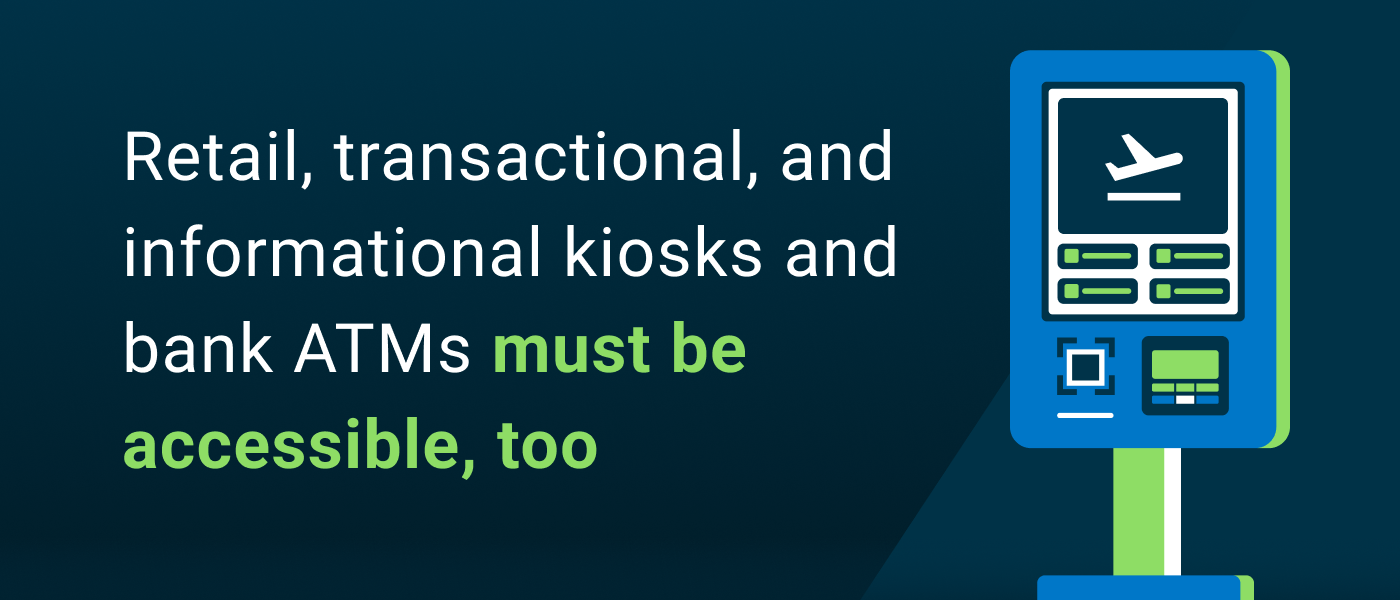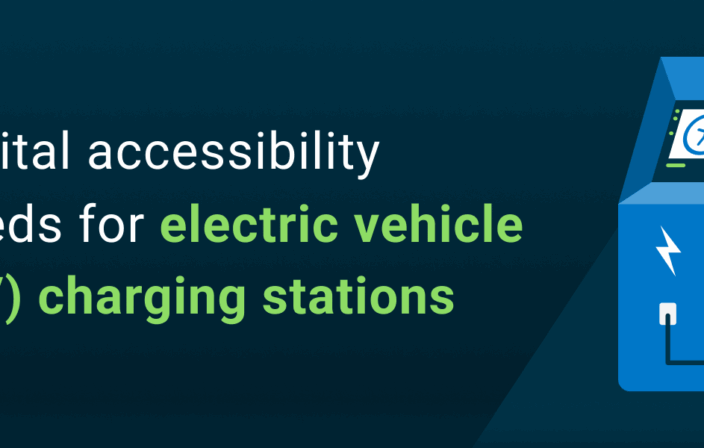Think about all the places you’ve been to during the past few weeks, and try to remember how many different self-service kiosks you have used along the way. It’s probably more than you thought!
You might have paid for parking at a smart meter or charged your car at an EV charging station. Maybe you used an ATM to get cash or deposit a check. Perhaps you snagged tickets to a show or used the grocery store’s self-checkout. If you were at an airport, you probably checked in and printed your boarding pass at an airline kiosk.
Interactive kiosks have become familiar fixtures in our lives. They’re convenient, helping us to live independently. They often act as extensions of our personal devices in public places, making it easy to complete all sorts of transactions.
Everyone who uses a kiosk wants a fast, easy, and intuitive experience—including people with disabilities, who represent one-fourth of U.S. adults (2022 data) and 16 percent of the global population. Unfortunately, despite these numbers, kiosks are too often not built to be accessible.
This has to change. Companies that use kiosks to interact with their customers must understand that accessibility is not only ethical and inclusive—it’s a business and a legal issue. Excluding the world’s largest minority can make your organization vulnerable to lawsuits and complaints, and you’re potentially blocking a large percentage of your customers from using your service.
The global interactive kiosk market is projected to grow significantly, with estimates ranging from $32.5 billion in 2023 to $63.3 billion by 2032, according to Zion Market Research. ATM kiosks are expected to dominate the US market with $16 billion in revenue, followed by retail use cases that include quick-service restaurants, ticketing, bill-pay, gaming, hospitality, and photos.
Ensuring that kiosks are accessible is essential for businesses and customers alike. In this post, I’ll examine what makes kiosks unique, clarify existing regulations, and share best practices for meeting the needs of all users.
What makes kiosks unique?
Kiosks require a simple user interface that can be used without training or documentation. They are designed for customers to conduct unattended transactions.
Kiosk interfaces can be coded using familiar operating systems such as Windows, macOS, Android, iOS, and Linux. Because the industry has many specialty vendors supplying custom tech stacks, there is no one self-service solution that can simplify achieving accessibility.
Another critical aspect of free-standing kiosks is that they prohibit users from attaching assistive technologies. Their public location mandates that users cannot install a preferred screen reader or screen enlargement software nor bring a keyboard or pointing device. This is known as “self-contained” or closed functionality. This limitation changes how accessibility is managed.
Why kiosks must be physically and digitally accessible
When considering kiosk accessibility, most people think of wheelchair access. Is the kiosk located at the top of the stairs with no ramp? Are the controls within reach? Can the screen be seen?
While meeting physical standards for clearance and maneuvering is essential, digital content must also be accessible. Otherwise, people who cannot see or interact with touchscreen displays are blocked from using the service.
A kiosk or ATM owner is responsible for providing accessibility for both the hardware and software.
Here are two foundational accessibility solutions that can help people with no or low vision use kiosks:
- Offer the option to insert a cabled earphone or earbuds into the mini jack to activate a speech engine. Some providers call this accessibility mode.
- Include a tactile physical keypad that allows people with no or low vision to navigate and activate controls. A common product uses a four-way directional control with a center action button.
Determining which standards apply to kiosks
Evaluating kiosk and ATM accessibility is a specialized process, and it’s important to understand that, unlike with web accessibility, there are no universal kiosk accessibility guidelines that provide the path to conformance. For example:
- The Web Content Accessibility Guidelines (WCAG) are not focused on kiosks but include many relevant provisions.
- The W3C Web Accessibility Initiative (WAI) had ATMs and other closed systems in mind when documenting non-web content (Guidance on Applying WCAG 2 to Non-Web Information and Communications Technologies).
Because of this, you’ll need to create a blended set of guidelines.
Let’s look at several crucial standards and explore how each can contribute to a recipe of combined checkpoints.
For specific industries, we have these regulations as starting points:
- Americans With Disabilities Act (ADA) Section 707 for Automatic Teller Machines and Fare Machines
- Air Carrier Access Act (ACAA) for airport terminal machines
For retail, informational, point-of-sale (POS) machines, or other non-ATM, non-airline kiosks, we can consult:
- Americans With Disabilities Act (ADA) Title II
- Revised Section 508 of the Rehabilitation Act
- European Standard EN 301 549
- Web Content Accessibility Guidelines (WCAG)
ADA Section 707 for ATMs
As of March 2012, bank ATMs in the US are required to comply with the 2010 ADA Standards for Accessible Design from the US Department of Justice, specifically Section 707, Automatic Teller Machines and Fare Machines, which do not apply to other types of self-service machines.
Section 707 defines requirements from operable parts and privacy to speech output and tactile input keys. It also covers braille instructions and issues such as the physical spacing that allows people with wheelchairs to approach and access the content.
ACAA for airport terminals
The 2013 U.S. Air Carrier Access Act (ACAA) outlines accessibility requirements for automated airport kiosks. Checkpoints for content specify character size, color contrast, masking characters for security, and speech output, among others.
The regulations require that 25% of kiosks installed on or after December 12, 2016, be accessible to people with disabilities and that 25% of all kiosks be accessible after December 12, 2022.
Americans With Disabilities Act (ADA) Title II
On April 24, 2024, the Department of Justice (DOJ) passed a rule under ADA Title II mandating that state and local governments and their third-party contractors and software vendors must comply with WCAG 2.1 A/AA standards. Depending on the size of the population served, organizations have two or three years to comply.
This law ensures that public services provided through digital platforms are usable by everyone, including individuals with visual, auditory, motor, speech, and cognitive disabilities. Compliance with these standards is crucial for providing equitable access to essential services such as paying taxes, accessing public records, and participating in community events.
The regulation has specific implications for third-party vendors of digitally delivered platforms, including parking payment apps, payment processors, event ticketing, and other digital public service tools.
Revised Section 508
In 1998, Congress amended the Rehabilitation Act of 1973 to require federal agencies to make their electronic and information technology (EIT) accessible to people with disabilities. Section 508 says all public-facing electronic content must be accessible. It cites self-service machines and information kiosks as examples of information and communication technology (ICT) with closed functionality.
If the content is not web-based, Section 508 says it must conform to all WCAG 2.0 A & AA success criteria, with a few exceptions. Chapter 2: Scoping Requirements lays out where non-web content is exempt. Section 508 gets more precise on kiosks than WCAG does, including technical criteria for the hardware. As a procurement law, Section 508 is enforced through consumers filing formal complaints.
European Standard EN 301 549
The European Accessibility Act, which will take effect in June 2025, requires that kiosks such as ticketing and check-in machines, information terminals, and ATMs be accessible to people with disabilities across the EU. This will unify accessibility across EU member states, reducing compliance barriers for businesses while fostering a more inclusive digital landscape.
The essential international standard to become familiar with is EN 301 549, a procurement guideline similar to 508 called “Accessibility requirements for ICT products and services in Europe.” To survive in a competitive global market, kiosk manufacturers and owners/operators must address European markets and these standards, which align with WCAG 2.1
WCAG
The Web Content Accessibility Guidelines (WCAG) provide guidance for building web pages, with the expectation that the device allows the user to bring assistive technologies on board. A kiosk deployment may use a web browser and HTML, but it will be pared back to essential transactional content only and probably relies on a touchscreen and keypad combination. Certain WCAG guidelines are not written for closed functionality, but others can inform and aid the development of built-in accessible alternatives.
One example of a WCAG success criterion that can be leveraged for kiosk interfaces is 3.3.4 Error Prevention (Legal, Financial, Data): If the user can change or delete legal, financial, student exam responses, or unrecoverable/unintentionally modified or deleted data, the changes/deletions must be reversible, verified, or confirmed. It’s a critical reality check: If the user is getting ready to submit a form or initiate an action that has real consequences for them (such as financial or legal commitments), then they are given a chance to review and change or cancel the transaction.
Your kiosk or ATM accessibility journey
As an interactive kiosk owner, if your software is already built, you may need to conduct an accessibility audit to determine its accessibility. If you are in the design phase or just now building your software and need guidance, Deque has specialized kiosk accessibility coaches that can help you incorporate accessibility at every step.
Deque’s methodology relies on a phased and pragmatic approach that enables testing to occur as accessibility measures are implemented, making the path to accessibility manageable:
- The first phase is a visual test of screens using a remote emulator.
- The second phase examines the physical keypad or keyboard to ensure navigation order, visible focus states, and, most importantly, that all functionality can be performed without using the touchscreen interface.
- The third phase tests the speech output that takes the place of traditional screen reader software and may include scriptwriting.
- The final phase involves functional usability testing with people with disabilities, to validate that everything works in the real world as you designed it to.
If a kiosk assessment is driven by a complaint or a lawsuit, the standard to which you must test may be referenced in the legal brief. Be sure to review this document with your accessibility consultant before landing on your specific checkpoints to avoid wasting time, effort, and money.
Rulemaking for self-service machines is coming
A proposed legal update for interactive kiosks in the US appears to be on the horizon. On May 24, 2024, the US Access Board published a proposed rule that could provide supplemental ADA guidelines for self-service equipment to be used in public accommodations. The DOJ will be solely responsible for determining when the requirements will become effective.
When the results are eventually codified, it may lead to less ambiguity in achieving accessibility with kiosks. This is good news for customers and reinforces the need to build accessible kiosks and remediate existing ones now.
Postponing accessibility debt will only increase exposure to legal risk and take more away from your bottom line. You can follow Seyfarth’s ADA Title III coverage and articles from attorney Lainey Feingold for more information about kiosk legal cases and regulatory developments.
Good news: All kiosks can be made accessible
As we always say in the accessibility industry, avoiding problems in the first place is always better than trying to fix them later.
When it comes to kiosks and ATMS, commit to assessing the needs of all users early and throughout the design, development, and testing lifecycle. Kiosks and ATMs can be made fully accessible and meet regulatory requirements, which is good for humans and good for business.
Contact us today to learn how we can partner to create self-service success stories.



